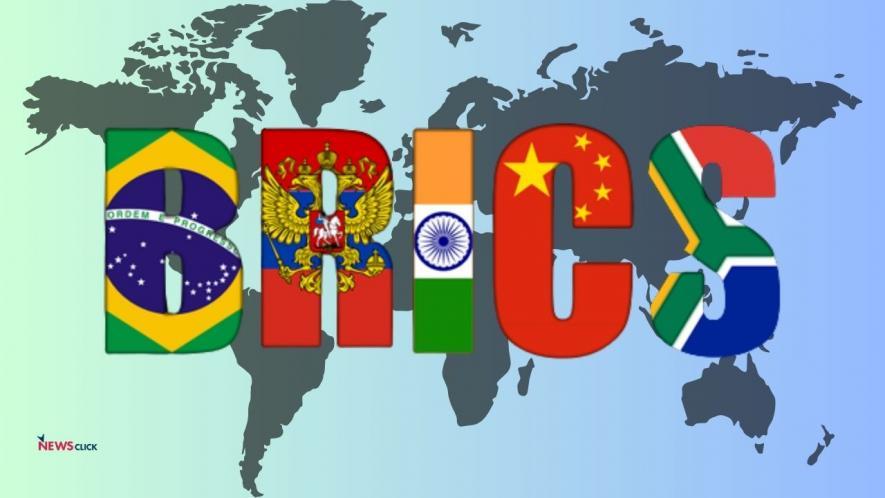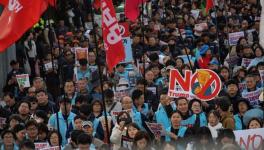BRICS: Political Economy & Quest for Systemic Alternatives

The 2025 BRICS Leaders’ Declaration from Rio de Janeiro marks a pivotal moment in the evolving architecture of the global political economy. For the first time, a significantly expanded BRICS bloc has articulated, if not yet institutionalised, a coordinated intention to loosen the structural grip of US-led imperialist hegemony. While couched in the language of multilateral reform, the underlying critique of the neoliberal world order and the asymmetries of power embedded in global financial governance is unmistakable.
This shift signals the convergence of three unfolding trajectories that warrant close scrutiny. First, the growing momentum toward de-dollarisation and the restructuring of international financial institutions, which challenges the dominance of the dollar and its regime of policy conditionalities.
Second, India’s strategic equivocation, caught between aspirations for leadership in the Global South and a foreign policy increasingly tethered to Washington’s geopolitical imperatives.
And third, the emergence of a contested but real political opening for systemic alternatives, particularly for Left movements seeking to move beyond the constraints of neoliberal orthodoxy.
This article argues that while BRICS is not a socialist formation, its collective challenge to the imperial architecture of global finance has weakened the coercive reach of metropolitan capital. In doing so, it has created new possibilities for developmental sovereignty, economic justice, and democratic planning.
It is in this context that India’s contradictory foreign policy stance, driven by a neofascist domestic dispensation and a misplaced faith in US strategic patronage, appears not only politically short-sighted but increasingly consequential in isolating India from the very spaces of global transformation it once sought to lead.
Challenging US Imperialist Hegemony
The 2025 Rio Declaration of BRICS delivers a comprehensive indictment of the prevailing neoliberal international financial architecture. It calls for significant reform and offers in broad outline an institutional roadmap for an alternative to the current US-centric international order (which is gradually declining). Through paragraphs 10–13 of the 2025 Rio Declaration, BRICS decries the disproportionate influence of the US-dominated International Monetary Fund (IMF) and World Bank, insisting on new governance formulae that reflect the current economic rise of the Global South.
Proposals to revise IMF quotas and increase the representation of emerging markets and developing economies (EMDEs) in World Bank shareholding signify a frontal challenge to the veto powers that the US government and its "allies" exercise over these institutions.
A core thrust of the 2025 Rio Declaration is the operationalisation of non-dollar financial pathways. Proposed measures in this regard include: one, local currency financing via the New Development Bank or NDB (discussed in paragraph 45); two, cross-border payments infrastructure that bypasses the dollar (expounded in Paragraph 50); three, financial coordination via the Interbank Cooperation Mechanism (set out in Paragraph 49).
All these proposals indicate a determination to erect an alternative to the US-dominated SWIFT or Society for Worldwide Interbank Financial Telecommunication which, at the very least, involves an intention to reduce dependency on the dollar in intra-BRICS trade.
The Contingent Reserve Arrangement (CRA) is being revised to expand payment options and strengthen autonomy from the IMF’s (neoliberal) conditionalities-based frameworks (as laid out in paragraph 53). This signals BRICS’ intent to provide counter-cyclical liquidity support that is insulated from policy leverage that may be exercised by the US government.
Paragraphs 48 and 51 of the 2025 Rio Declaration deal with proposals about novel financial instruments and insurance mechanisms. These include new guarantees, risk instruments, and (re)insurance initiatives that it is suggested could emerge within a BRICS financial ecosystem which might offer a platform to finance Global South investments that is autonomous of the policy intentions of the US government.
De-dollarisation is an objective process reflected, for instance, in the calls by the denizens of international finance capital for the US to cut its trade deficit. Given the evident limitations of the US Trump Presidency to reduce its trade deficit through coercive trade measures, this call has effectively involved calls for the US government to cut its budget deficit. Given the US Trump Presidency's commitment to providing tax breaks to US monopoly capital, the US Trump Presidency has gone in for reinforced public expenditure compression through measures such as the "big beautiful bill".
In other words, as de-dollarisation proceeds, the international reserve currency status of the dollar starts declining; the US economy is making a gradual shift from a situation where the rest of the world's lending to the US adjusts to the US trade deficit (making US fiscal policy) to one where the trade deficit (and therefore fiscal policy and output) has to adjust to the lending that the rest of the world is willing to make to the US economy.
The 2025 Rio Declaration demands urgent WTO or World Trade Organisation reform, calling out “green protectionism” and unilateralism in paragraph 13, thereby reiterating and affirming differentially favourable treatment for developing economies since the elites of metropolitan countries bear the principal responsibility for cumulative greenhouse gas emissions.
It is indeed ironic that WTO, which was set up at the instance of metropolitan capital led by the US in the 1990s, is now being increasingly abandoned by these very same elites since China has comprehensively ascended the technological ladder that pertains to global production networks.
These measures involve both de-dollarisation and de-centering of US monopoly capital from international trade, if implemented and built on, are objectively capable of accelerating the relative decline of US capital with respect to the rest of the world making the quest for systemic alternatives in the world less involved.
India’s Strategic Equivocation: Between Alignment & Autonomy
The current Indian government’s engagement with BRICS remains persistently ambivalent. While it seems to endorse the broad contours of the Rio Declaration, its actual strategic posture betrays a misreading of the international political economy. This contradiction is not merely tactical, and stems from a flawed premise that China poses a greater threat to India’s strategic interests than the US.
It is naive to expect that the strategic interests of a great power will coincide with that of another country. The perpetuation of the division of Eurasia is a necessary condition of US imperialist hegemony. No matter the historical origins of these divisions in Eurasia, the policies of the US government (that are reminiscent of the policies of colonial powers in this regard), especially since 1945, are the principal drivers of these divisions.
Seemingly based on the flawed strategic assumption that China is the purportedly greater threat, India’s foreign policy is being recalibrated within the following policy contours: the prioritisation of the ostensible need to counter China; this in turn requires a deepening of India's strategic proximity to the US government; and notwithstanding the deleterious impact of this proximity, vainly staking claim to leadership in the Global South.
These contradictory contours of India's foreign policy, especially since 2024, result in a profound policy schizophrenia when it comes to de-dollarisation and the quest for alternatives to the one that is hegemonised by US-led metropolitan capital.
The current neofascist ruling dispensation is driving India’s deepening military and technology ties with Washington based on the inadequate premise (as previously argued) that: one, this strategic posture by itself can reverse the relative decline of the US with respect to China; two, that US monopoly capital will act in ways that will further India's national interests to a greater extent than what China will do. The actions of the second US Trump Presidency are a clear demonstration of the invalidity of this premise.
But wedded to its chimerical premises, the neofascist ruling dispensation is making India the principal hurdle within BRICS to the agenda of de-dollarisation. However, the agenda of de-dollarisation is likely to proceed notwithstanding Indian opposition. It is in fact arguable that the neofascist ruling dispensation erroneously sees its opposition to de-dollarisation within BRICS as a means to heighten its strategic proximity to US monopoly capital.
Any form of de-dollarisation will involve challenges. India’s foreign reserves, energy trade, and remittance flows remain largely US dollar-denominated. A sudden move toward complete de-dollarisation is likely to increase currency volatility, transaction inefficiencies, and financial instability. But the proposed moves by BRICS involve gradual changes towards de-dollarisation that are feasible.
The Indian ruling classes (including the neofascist ruling dispensation) rightly perceive that de-dollarisation is likely to be centered around the Chinese Renminbi. Further, the domestic corporate-financial oligarchy is deeply incorporated into the ambit of international finance capital.
Therefore, the ruling dispensation foregrounds factors such as the Chinese weight within BRICS, and purported limitations in currency convertibility in the de-dollarisation framework. But the consideration regarding currency convertibility applies to other members of BRICS too with the evident exception of China. Therefore, it is the (likely eventual) centering of Chinese Renminbi in the de-dollarisation process that is the principal concern of India's neofascist ruling dispensation.
However, this opposition to de-dollarisation seems to derive from the strategic timidity of India's ruling classes with respect to US monopoly capital as evidenced by the neofascist ruling dispensation's foreign policy stance on conflicts in West Asia for instance.
Given the more sober assessment by ever more sections of international finance capital about the irreversible relative decline of US monopoly capital with respect to the rest of the world, it will not be too amiss to conclude that the neofascist ruling dispensation's understanding involves a substantial dose of self-deception. This is compounded by US monopoly capital's proclivity to take advantage of the neofascist ruling dispensation's quest for strategic proximity towards the US government as evidenced by the strategic setbacks to the detriment of India's national interests during for instance the days-long military confrontation between Pakistan and India as well as the trade negotiations between the US and India.
This self-deception involves a chimerical quest to distinguish between advocating for multilateral reform (e.g., United Nations Security Council) and being chary about fully endorsing parallel, BRICS-led institutional alternatives to US-led ones. This quest is chimerical since it is the growing consolidation of BRICS that is leading to the relative decline of US monopoly capital. The only definitive consequence of this chimerical quest, as previously pointed out, is India's strategic isolation from the rest of the Global South.
Consolidation of BRICS and Political Space for Left Alternatives
BRICS is not a socialist project. But it is undeniable that the rise of BRICS by weakening metropolitan capital has objectively expanded the space for systemic alternatives. The issues highlighted in the 2025 Rio BRICS declaration emphasise sovereignty, development rights, opposition to unilateral sanctions, inequality, labour rights, ecological transitions, and digital justice. This constitutes the logical form in the current conjuncture of some foundational principles of anti-imperialism. The Declaration also reaffirms the centrality of industrial policy, government in a clear break with the neoliberal ideological corpus whereby the US state pursued industrial policy by stealth while every other state was compelled to submit to the dictates of US-centered international finance capital which was obfuscated through the mythology of ostensibly "free markets".
The contours of future conflicts between metropolitan capital and BRICS could provide political space for the Left to craft systemic alternatives. Needless to say, this political space can be fully available for such alternatives only if the movements in question consistently exercise strategic autonomy.
Assertion of Multipolarity
The 2025 Rio Declaration marks more than a symbolic assertion of multipolarity, it signifies an evolving challenge to the economic and institutional architecture long dominated by US-led metropolitan capital. Through proposals for local currency settlements, financial infrastructure independent of SWIFT, and a reimagined Contingent Reserve Arrangement, BRICS has begun to articulate a viable departure from the coercive logic of neoliberal finance. These steps, though still nascent, signal a conscious effort to carve out greater policy autonomy and reclaim developmental sovereignty.
Yet this moment of strategic possibility is fraught with contradictions. Chief among them is India’s deepening equivocation. In subordinating its geopolitical imagination to a flawed calculus that privileges proximity to the US over rational prognosis that necessarily involves solidarity with the Global South, the neofascist ruling dispensation risks alienating India from the very currents of change that BRICS now embodies. This is not simply a tactical misstep—it reflects a deeper ideological submission to the interests of international finance capital and a refusal to confront the structural hierarchies that sustain imperial hegemony.
Nonetheless, the expanding institutional footprint of BRICS opens new political space, the task is to engage critically with its contradictions while asserting autonomous, democratically grounded visions of global justice. The weakening of metropolitan capital’s coercive power, if harnessed strategically, could allow for a renewed politics of redistribution, democratic planning, and ecological transition. In this conjuncture, the terrain of political struggle is shifting. The question, then, is not whether an alternative order is possible but whether we are prepared to shape it before it is shaped for us.
Shirin Akhter is Associate Professor at Zakir Husain Delhi College, University of Delhi. C Saratchand is Professor, Department of Economics, Satyawati College, University of Delhi. The views are personal.
Get the latest reports & analysis with people's perspective on Protests, movements & deep analytical videos, discussions of the current affairs in your Telegram app. Subscribe to NewsClick's Telegram channel & get Real-Time updates on stories, as they get published on our website.
























